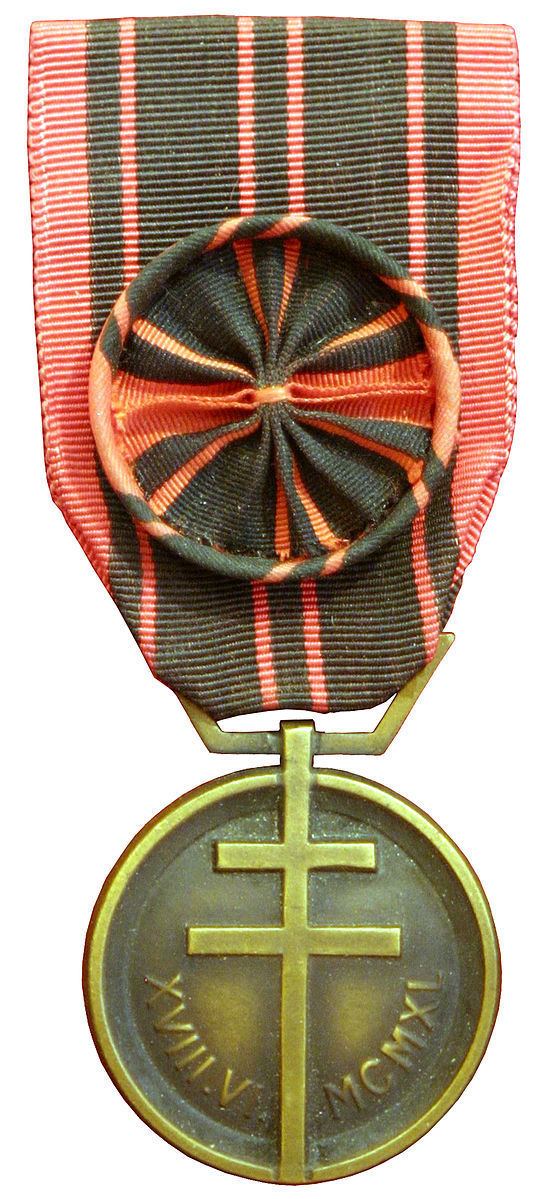The Resistance medal (French: Médaille de la Résistance) was a decoration bestowed by the French Committee of National Liberation, based in the United Kingdom, during World War II. It was established by a decree of General Charles de Gaulle on 9 February 1943 "to recognize the remarkable acts of faith and of courage that, in France, in the empire and abroad, have contributed to the resistance of the French people against the enemy and against its accomplices since 18 June 1940".
The Resistance medal was awarded to approximately 38,288 living persons and 24,463 posthumously. These awards were both for membership in the Free French forces and for participation in the metropolitan clandestine Resistance during the German occupation of France in World War II. Higher deeds were rewarded with the Ordre de la Libération. Proposals for the medal ceased to be accepted on 31 March 1947. For acts that occurred in Indochina, however, that date was moved back to 31 December 1947.
The medal was also awarded to 18 communities and territories, 21 military units, and to 15 other organizations including convents, high schools, and hospitals that particularly distinguished themselves.
The Resistance medal is awarded by the Chief of a Fighting France to French individuals and communities:
who took an especially active part since 18 June 1940 in the resistance against Axis forces and their accomplices on French soil or in a territory under French sovereignty;who took and effective and important part in the rallying of French territories to Fighting France or rendered services in the war effort of those territories that were confirmed and logged;who played an eminent role in the actions of organizations of Fighting France abroad or in propaganda destined at regrouping and supporting the forces of the resistance;who rallied troops, ships or aircraft in exceptionally difficult or dangerous conditions;who joined the Free French Forces in particularly dangerous and meritorious conditions.The Resistance medal may be revoked by decree following any act contrary to honour or integrity, whether committed prior to or after bestowal of the medal.
The Resistance medal is a 37mm in diameter circular medal struck from bronze. Its slightly concave obverse bears at center a vertical Cross of Lorraine with the relief semi circular inscription of the date of General de Gaulle's appeal of 18 June 1940 in Roman numerals "XVIII.VI.MCMXL" (18.06.1940) bisected by the lower part of the cross. The reverse bears the relief image of an unfurling ribbon bearing the relief inscription in Latin "PATRIA NON IMMEMOR" translating into "THE NATION DOES NOT FORGET". The suspension is cast as an integral part of the medal.
The medal hangs from a 36mm wide black silk moiré ribbon with six vertical red stripes of varying widths, 3mm wide edge stripes, two 1mm wide central stripes 2mm apart, and two 1mm wide stripes 6mm from the central stripes. A 28mm in diameter rosette is on the ribbon of the Officer of the Resistance medal.
Resistance leader Jean Pierre-BlochResistance member Josephine BakerResistance member Albert HaarResistance member Andrzej KuśniewiczResistance member Georges CaussanelResistance member Jane VialleResistance member lieutenant Henry AndraudResistance member Marcel DufricheResistance member Édouard Le Jeune, former SenatorResistance leader Colonel Émile CoulaudonAdmiral Philippe AuboyneauLieutenant General Marcel BigeardForeign Legion general Bernard Saint-HillierForeign Legion Lieutenant Colonel Pierre JeanpierreFrench paratrooper André Zirnheld (The Paratrooper's Prayer)Writer, statesman, resistance member André MalrauxIrish playwright, director, novelist Samuel BeckettResistance leader Pierre Kahn-FarellePolitician, resistance member general Pierre de BénouvilleResistance member doctor Charles CliquetResistance member Jeanne L'HerminierFree French soldier general François BinocheResistance Leader Camille NicolasFree French Forces and Office of Strategic Services Captain René JoyeuseDiplomat Louis Alexis Étienne BonvinResistance member Émile BollaertResistance leader Edmond ProustFree French soldier warrant officer Walter GrandResistance leader Joseph DubarFree French navy admiral Georges Thierry d'ArgenlieuResistance member, captain in the French military, French art historian and "Monuments Men" member Rose Valland.Grenoble resistance member Jean PainFree French aviator lieutenant Gérard ClaronFree French aviator captain Louis Flury-HérardResistance leader general Aubert FrèreCaptain, doctor, mayor of Saint-Rambert-en-Bugey, Michel TemporalResistance member Pierre GuillouFree French aviator Pierre Brisdoux Galloni d'IstriaResistance leader Fernand ZalkinowResistance member colonel Émile BonotauxResistance member brigadier general Georges JournoisAbbot René BonpainResistance leader Pierre BrossoletteResistance leader Pierre KaanResistance member Léger FourisResistance member Gabriel PlançonResistance member rabbi Samuel KleinResistance member Laurent MatheronResistance leader Marc HaguenauResistance member Georges LamarqueResistance leader rear admiral Jacques Trolley de PrévauxResistance member Jean ChaffanjonResistance member Pierre ChaffanjonResistance member Robert DuterqueRecipient communities and organizations (partial list)
Oyonnax communeUniversity of StrasbourgMontceau-les-Mines communeLalande de Bourg-en-Bresse high school6th Engineers RegimentPreparatory Military School of AutunMarsoulas communeCaniac-du-Causse communeMiribel communeBéthincourt communeMeximieux commune1st Line Infantry RegimentTerrou communeNantua communeNotre-Dame de Timadeuc abbeySubmarine Surcouf13th Demi-Brigade of the Foreign Legion1st Marines RegimentCity of BrestCaen commune
